Critical Analysis of Indigenous Health Determinants in Australia
VerifiedAdded on 2022/08/21
|9
|2155
|20
Essay
AI Summary
This essay provides a comprehensive analysis of the determinants of Indigenous health in Australia. It explores historical factors, such as colonization and its impact on health outcomes, including the introduction of diseases, land dispossession, and the stolen generations. The essay also examines social determinants, including income, education, employment, housing, and access to healthcare, and their influence on health behaviors and outcomes. Cultural determinants, such as cultural safety, identity, and traditions, are also discussed. Furthermore, the essay highlights the role of nurses in providing culturally safe and competent care, referencing relevant codes of conduct and government initiatives like "Closing the Gap" and Koolin Balit. It emphasizes the importance of acknowledging historical injustices and promoting self-determination to improve Indigenous health outcomes.
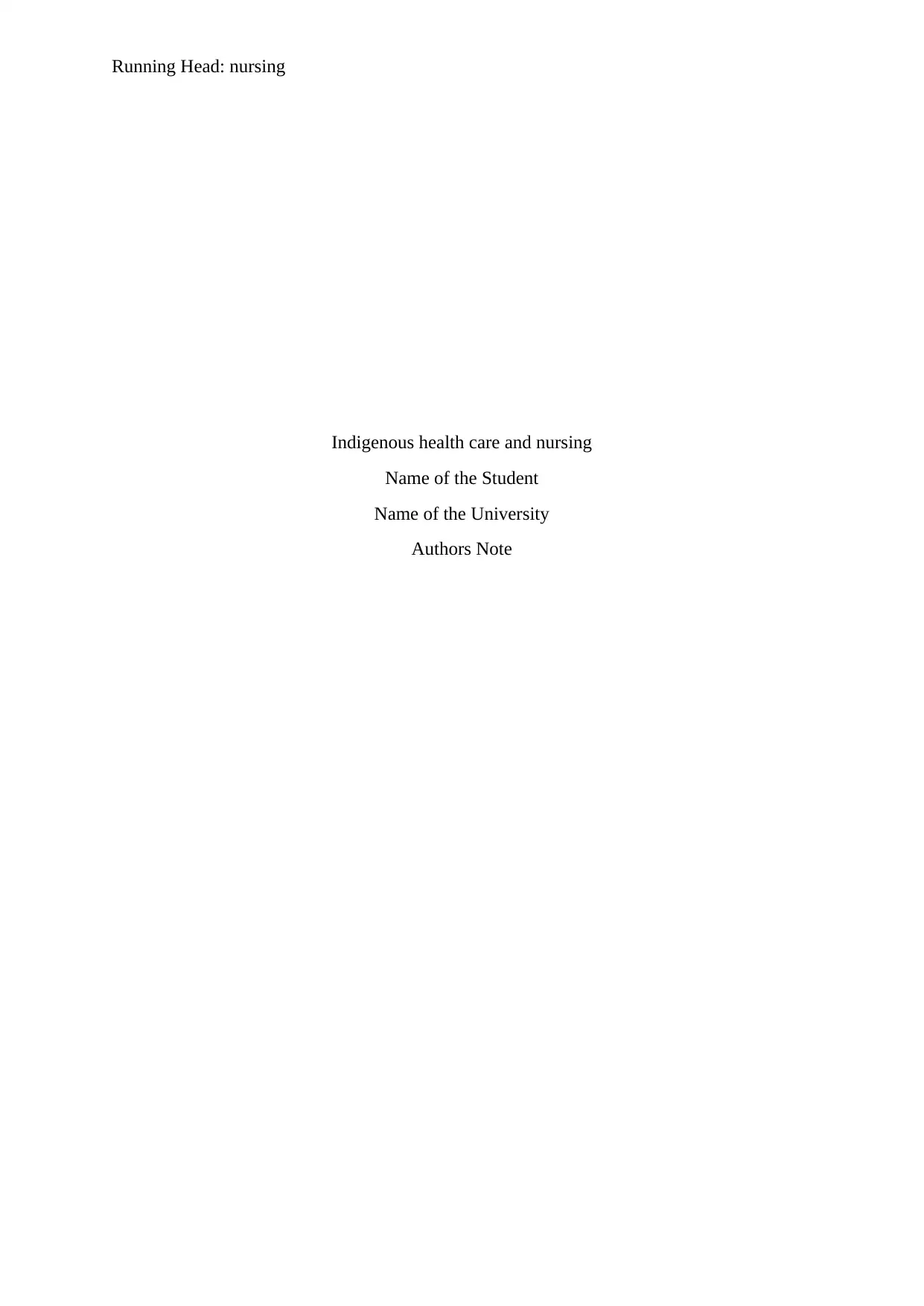
Running Head: nursing
Indigenous health care and nursing
Name of the Student
Name of the University
Authors Note
Indigenous health care and nursing
Name of the Student
Name of the University
Authors Note
Paraphrase This Document
Need a fresh take? Get an instant paraphrase of this document with our AI Paraphraser
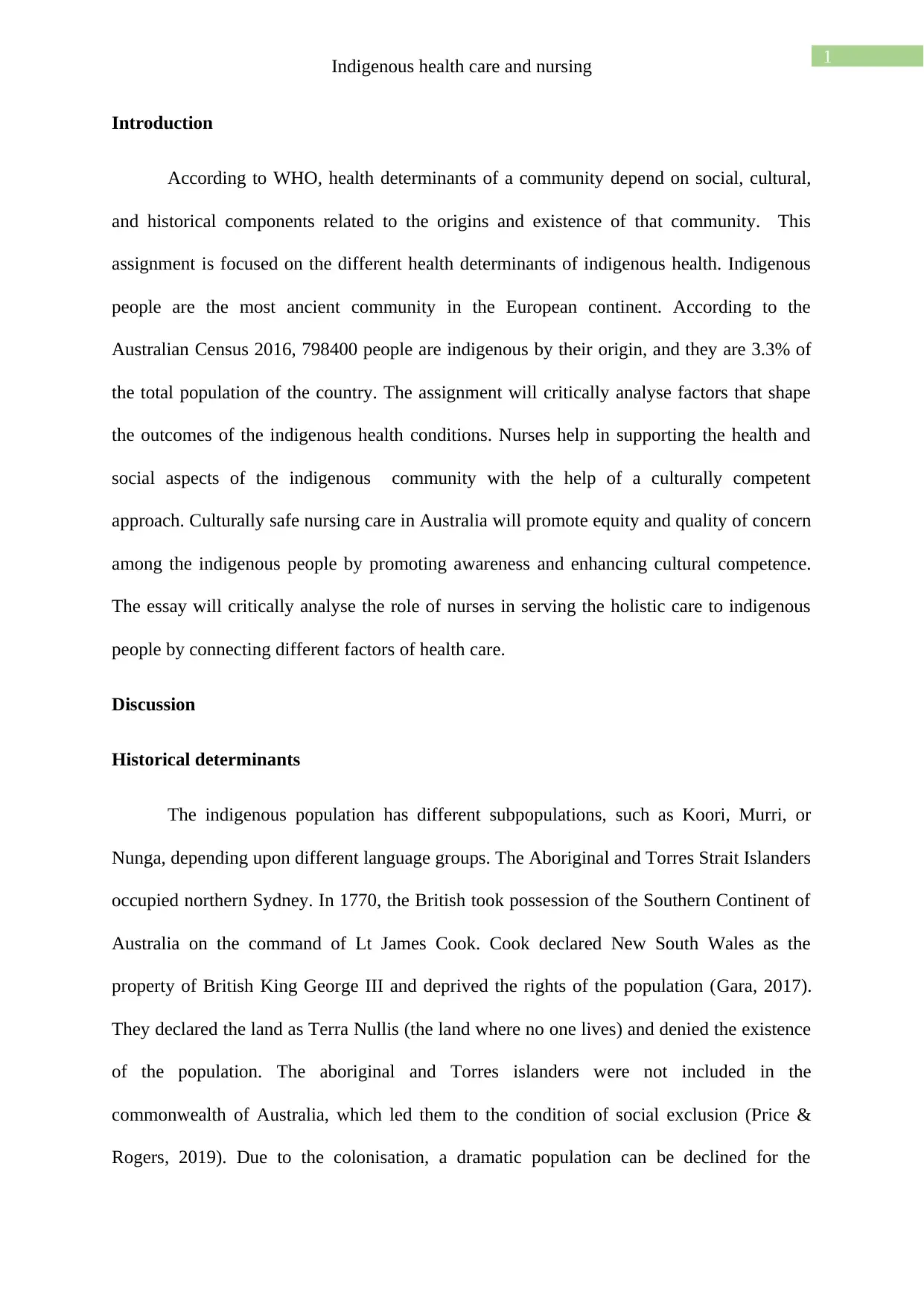
1
Indigenous health care and nursing
Introduction
According to WHO, health determinants of a community depend on social, cultural,
and historical components related to the origins and existence of that community. This
assignment is focused on the different health determinants of indigenous health. Indigenous
people are the most ancient community in the European continent. According to the
Australian Census 2016, 798400 people are indigenous by their origin, and they are 3.3% of
the total population of the country. The assignment will critically analyse factors that shape
the outcomes of the indigenous health conditions. Nurses help in supporting the health and
social aspects of the indigenous community with the help of a culturally competent
approach. Culturally safe nursing care in Australia will promote equity and quality of concern
among the indigenous people by promoting awareness and enhancing cultural competence.
The essay will critically analyse the role of nurses in serving the holistic care to indigenous
people by connecting different factors of health care.
Discussion
Historical determinants
The indigenous population has different subpopulations, such as Koori, Murri, or
Nunga, depending upon different language groups. The Aboriginal and Torres Strait Islanders
occupied northern Sydney. In 1770, the British took possession of the Southern Continent of
Australia on the command of Lt James Cook. Cook declared New South Wales as the
property of British King George III and deprived the rights of the population (Gara, 2017).
They declared the land as Terra Nullis (the land where no one lives) and denied the existence
of the population. The aboriginal and Torres islanders were not included in the
commonwealth of Australia, which led them to the condition of social exclusion (Price &
Rogers, 2019). Due to the colonisation, a dramatic population can be declined for the
Indigenous health care and nursing
Introduction
According to WHO, health determinants of a community depend on social, cultural,
and historical components related to the origins and existence of that community. This
assignment is focused on the different health determinants of indigenous health. Indigenous
people are the most ancient community in the European continent. According to the
Australian Census 2016, 798400 people are indigenous by their origin, and they are 3.3% of
the total population of the country. The assignment will critically analyse factors that shape
the outcomes of the indigenous health conditions. Nurses help in supporting the health and
social aspects of the indigenous community with the help of a culturally competent
approach. Culturally safe nursing care in Australia will promote equity and quality of concern
among the indigenous people by promoting awareness and enhancing cultural competence.
The essay will critically analyse the role of nurses in serving the holistic care to indigenous
people by connecting different factors of health care.
Discussion
Historical determinants
The indigenous population has different subpopulations, such as Koori, Murri, or
Nunga, depending upon different language groups. The Aboriginal and Torres Strait Islanders
occupied northern Sydney. In 1770, the British took possession of the Southern Continent of
Australia on the command of Lt James Cook. Cook declared New South Wales as the
property of British King George III and deprived the rights of the population (Gara, 2017).
They declared the land as Terra Nullis (the land where no one lives) and denied the existence
of the population. The aboriginal and Torres islanders were not included in the
commonwealth of Australia, which led them to the condition of social exclusion (Price &
Rogers, 2019). Due to the colonisation, a dramatic population can be declined for the
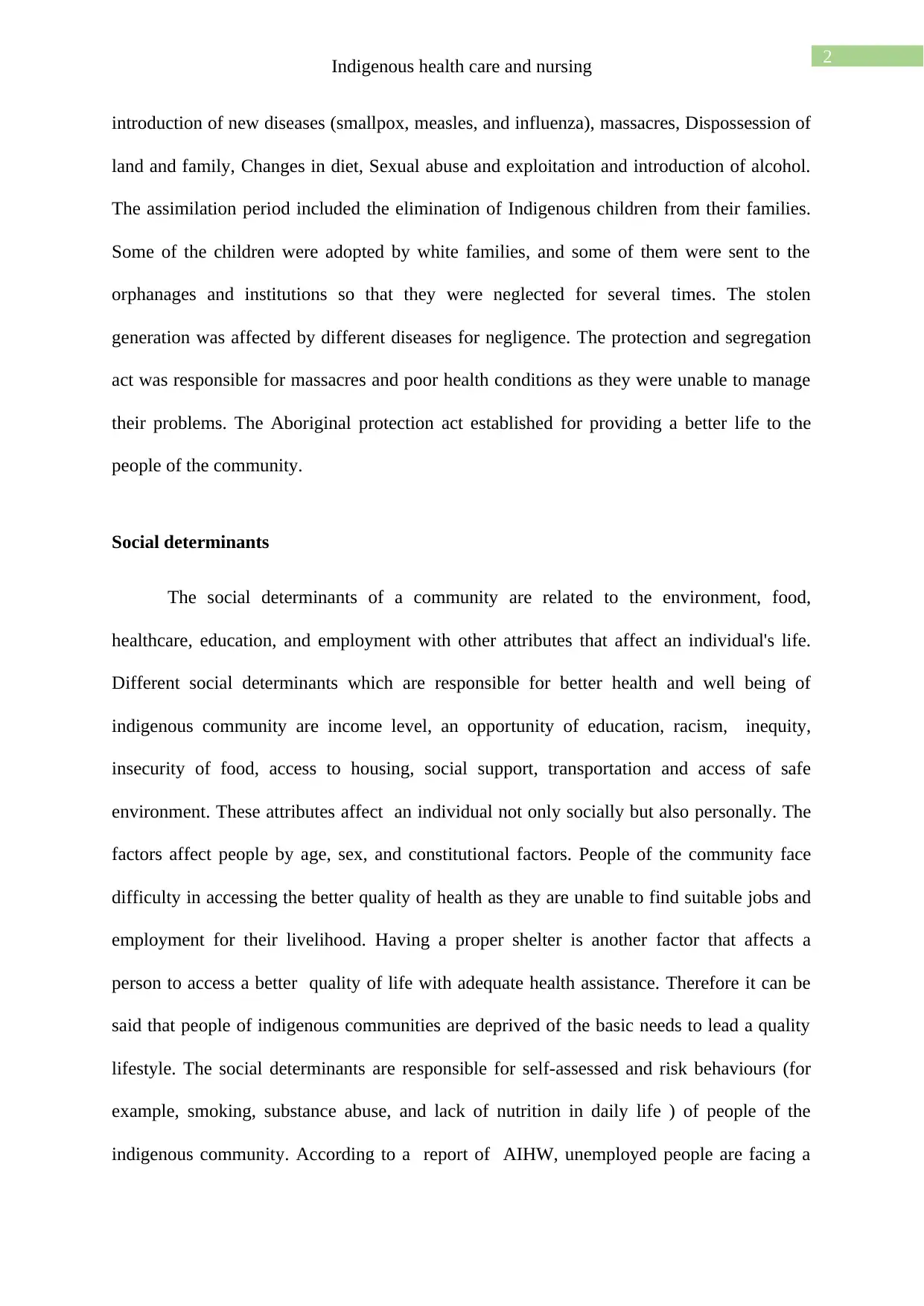
2
Indigenous health care and nursing
introduction of new diseases (smallpox, measles, and influenza), massacres, Dispossession of
land and family, Changes in diet, Sexual abuse and exploitation and introduction of alcohol.
The assimilation period included the elimination of Indigenous children from their families.
Some of the children were adopted by white families, and some of them were sent to the
orphanages and institutions so that they were neglected for several times. The stolen
generation was affected by different diseases for negligence. The protection and segregation
act was responsible for massacres and poor health conditions as they were unable to manage
their problems. The Aboriginal protection act established for providing a better life to the
people of the community.
Social determinants
The social determinants of a community are related to the environment, food,
healthcare, education, and employment with other attributes that affect an individual's life.
Different social determinants which are responsible for better health and well being of
indigenous community are income level, an opportunity of education, racism, inequity,
insecurity of food, access to housing, social support, transportation and access of safe
environment. These attributes affect an individual not only socially but also personally. The
factors affect people by age, sex, and constitutional factors. People of the community face
difficulty in accessing the better quality of health as they are unable to find suitable jobs and
employment for their livelihood. Having a proper shelter is another factor that affects a
person to access a better quality of life with adequate health assistance. Therefore it can be
said that people of indigenous communities are deprived of the basic needs to lead a quality
lifestyle. The social determinants are responsible for self-assessed and risk behaviours (for
example, smoking, substance abuse, and lack of nutrition in daily life ) of people of the
indigenous community. According to a report of AIHW, unemployed people are facing a
Indigenous health care and nursing
introduction of new diseases (smallpox, measles, and influenza), massacres, Dispossession of
land and family, Changes in diet, Sexual abuse and exploitation and introduction of alcohol.
The assimilation period included the elimination of Indigenous children from their families.
Some of the children were adopted by white families, and some of them were sent to the
orphanages and institutions so that they were neglected for several times. The stolen
generation was affected by different diseases for negligence. The protection and segregation
act was responsible for massacres and poor health conditions as they were unable to manage
their problems. The Aboriginal protection act established for providing a better life to the
people of the community.
Social determinants
The social determinants of a community are related to the environment, food,
healthcare, education, and employment with other attributes that affect an individual's life.
Different social determinants which are responsible for better health and well being of
indigenous community are income level, an opportunity of education, racism, inequity,
insecurity of food, access to housing, social support, transportation and access of safe
environment. These attributes affect an individual not only socially but also personally. The
factors affect people by age, sex, and constitutional factors. People of the community face
difficulty in accessing the better quality of health as they are unable to find suitable jobs and
employment for their livelihood. Having a proper shelter is another factor that affects a
person to access a better quality of life with adequate health assistance. Therefore it can be
said that people of indigenous communities are deprived of the basic needs to lead a quality
lifestyle. The social determinants are responsible for self-assessed and risk behaviours (for
example, smoking, substance abuse, and lack of nutrition in daily life ) of people of the
indigenous community. According to a report of AIHW, unemployed people are facing a
⊘ This is a preview!⊘
Do you want full access?
Subscribe today to unlock all pages.

Trusted by 1+ million students worldwide
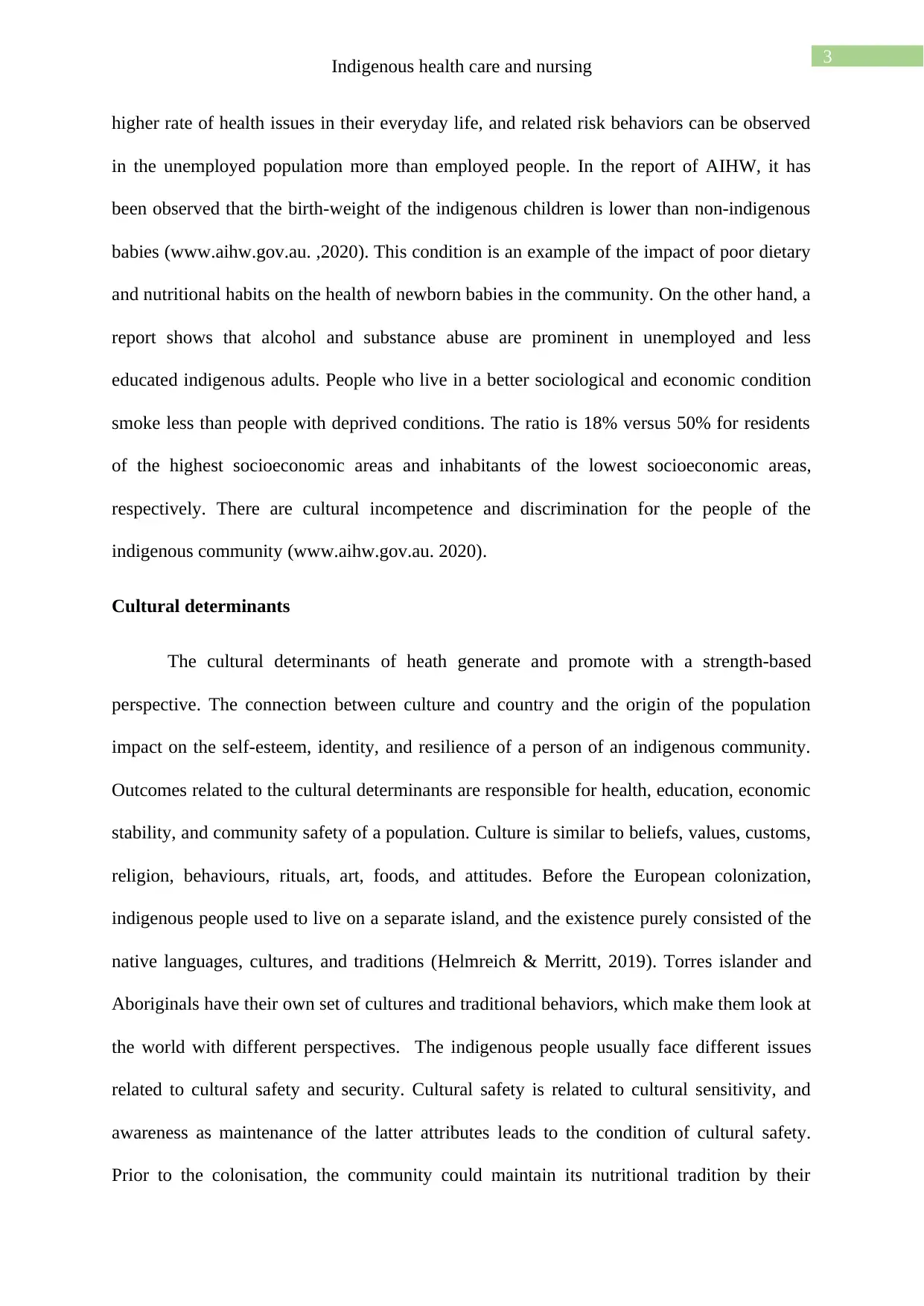
3
Indigenous health care and nursing
higher rate of health issues in their everyday life, and related risk behaviors can be observed
in the unemployed population more than employed people. In the report of AIHW, it has
been observed that the birth-weight of the indigenous children is lower than non-indigenous
babies (www.aihw.gov.au. ,2020). This condition is an example of the impact of poor dietary
and nutritional habits on the health of newborn babies in the community. On the other hand, a
report shows that alcohol and substance abuse are prominent in unemployed and less
educated indigenous adults. People who live in a better sociological and economic condition
smoke less than people with deprived conditions. The ratio is 18% versus 50% for residents
of the highest socioeconomic areas and inhabitants of the lowest socioeconomic areas,
respectively. There are cultural incompetence and discrimination for the people of the
indigenous community (www.aihw.gov.au. 2020).
Cultural determinants
The cultural determinants of heath generate and promote with a strength-based
perspective. The connection between culture and country and the origin of the population
impact on the self-esteem, identity, and resilience of a person of an indigenous community.
Outcomes related to the cultural determinants are responsible for health, education, economic
stability, and community safety of a population. Culture is similar to beliefs, values, customs,
religion, behaviours, rituals, art, foods, and attitudes. Before the European colonization,
indigenous people used to live on a separate island, and the existence purely consisted of the
native languages, cultures, and traditions (Helmreich & Merritt, 2019). Torres islander and
Aboriginals have their own set of cultures and traditional behaviors, which make them look at
the world with different perspectives. The indigenous people usually face different issues
related to cultural safety and security. Cultural safety is related to cultural sensitivity, and
awareness as maintenance of the latter attributes leads to the condition of cultural safety.
Prior to the colonisation, the community could maintain its nutritional tradition by their
Indigenous health care and nursing
higher rate of health issues in their everyday life, and related risk behaviors can be observed
in the unemployed population more than employed people. In the report of AIHW, it has
been observed that the birth-weight of the indigenous children is lower than non-indigenous
babies (www.aihw.gov.au. ,2020). This condition is an example of the impact of poor dietary
and nutritional habits on the health of newborn babies in the community. On the other hand, a
report shows that alcohol and substance abuse are prominent in unemployed and less
educated indigenous adults. People who live in a better sociological and economic condition
smoke less than people with deprived conditions. The ratio is 18% versus 50% for residents
of the highest socioeconomic areas and inhabitants of the lowest socioeconomic areas,
respectively. There are cultural incompetence and discrimination for the people of the
indigenous community (www.aihw.gov.au. 2020).
Cultural determinants
The cultural determinants of heath generate and promote with a strength-based
perspective. The connection between culture and country and the origin of the population
impact on the self-esteem, identity, and resilience of a person of an indigenous community.
Outcomes related to the cultural determinants are responsible for health, education, economic
stability, and community safety of a population. Culture is similar to beliefs, values, customs,
religion, behaviours, rituals, art, foods, and attitudes. Before the European colonization,
indigenous people used to live on a separate island, and the existence purely consisted of the
native languages, cultures, and traditions (Helmreich & Merritt, 2019). Torres islander and
Aboriginals have their own set of cultures and traditional behaviors, which make them look at
the world with different perspectives. The indigenous people usually face different issues
related to cultural safety and security. Cultural safety is related to cultural sensitivity, and
awareness as maintenance of the latter attributes leads to the condition of cultural safety.
Prior to the colonisation, the community could maintain its nutritional tradition by their
Paraphrase This Document
Need a fresh take? Get an instant paraphrase of this document with our AI Paraphraser
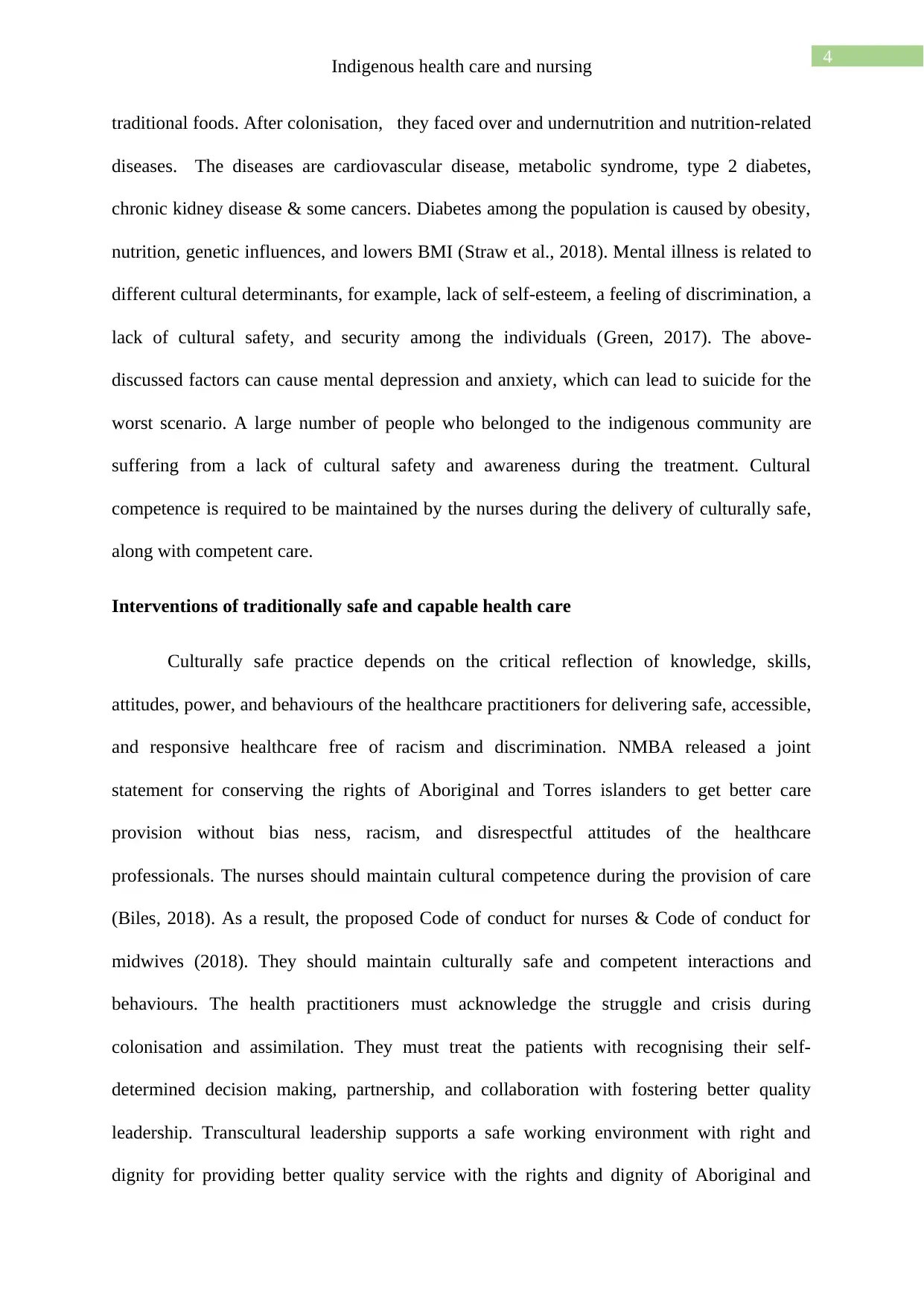
4
Indigenous health care and nursing
traditional foods. After colonisation, they faced over and undernutrition and nutrition-related
diseases. The diseases are cardiovascular disease, metabolic syndrome, type 2 diabetes,
chronic kidney disease & some cancers. Diabetes among the population is caused by obesity,
nutrition, genetic influences, and lowers BMI (Straw et al., 2018). Mental illness is related to
different cultural determinants, for example, lack of self-esteem, a feeling of discrimination, a
lack of cultural safety, and security among the individuals (Green, 2017). The above-
discussed factors can cause mental depression and anxiety, which can lead to suicide for the
worst scenario. A large number of people who belonged to the indigenous community are
suffering from a lack of cultural safety and awareness during the treatment. Cultural
competence is required to be maintained by the nurses during the delivery of culturally safe,
along with competent care.
Interventions of traditionally safe and capable health care
Culturally safe practice depends on the critical reflection of knowledge, skills,
attitudes, power, and behaviours of the healthcare practitioners for delivering safe, accessible,
and responsive healthcare free of racism and discrimination. NMBA released a joint
statement for conserving the rights of Aboriginal and Torres islanders to get better care
provision without bias ness, racism, and disrespectful attitudes of the healthcare
professionals. The nurses should maintain cultural competence during the provision of care
(Biles, 2018). As a result, the proposed Code of conduct for nurses & Code of conduct for
midwives (2018). They should maintain culturally safe and competent interactions and
behaviours. The health practitioners must acknowledge the struggle and crisis during
colonisation and assimilation. They must treat the patients with recognising their self-
determined decision making, partnership, and collaboration with fostering better quality
leadership. Transcultural leadership supports a safe working environment with right and
dignity for providing better quality service with the rights and dignity of Aboriginal and
Indigenous health care and nursing
traditional foods. After colonisation, they faced over and undernutrition and nutrition-related
diseases. The diseases are cardiovascular disease, metabolic syndrome, type 2 diabetes,
chronic kidney disease & some cancers. Diabetes among the population is caused by obesity,
nutrition, genetic influences, and lowers BMI (Straw et al., 2018). Mental illness is related to
different cultural determinants, for example, lack of self-esteem, a feeling of discrimination, a
lack of cultural safety, and security among the individuals (Green, 2017). The above-
discussed factors can cause mental depression and anxiety, which can lead to suicide for the
worst scenario. A large number of people who belonged to the indigenous community are
suffering from a lack of cultural safety and awareness during the treatment. Cultural
competence is required to be maintained by the nurses during the delivery of culturally safe,
along with competent care.
Interventions of traditionally safe and capable health care
Culturally safe practice depends on the critical reflection of knowledge, skills,
attitudes, power, and behaviours of the healthcare practitioners for delivering safe, accessible,
and responsive healthcare free of racism and discrimination. NMBA released a joint
statement for conserving the rights of Aboriginal and Torres islanders to get better care
provision without bias ness, racism, and disrespectful attitudes of the healthcare
professionals. The nurses should maintain cultural competence during the provision of care
(Biles, 2018). As a result, the proposed Code of conduct for nurses & Code of conduct for
midwives (2018). They should maintain culturally safe and competent interactions and
behaviours. The health practitioners must acknowledge the struggle and crisis during
colonisation and assimilation. They must treat the patients with recognising their self-
determined decision making, partnership, and collaboration with fostering better quality
leadership. Transcultural leadership supports a safe working environment with right and
dignity for providing better quality service with the rights and dignity of Aboriginal and
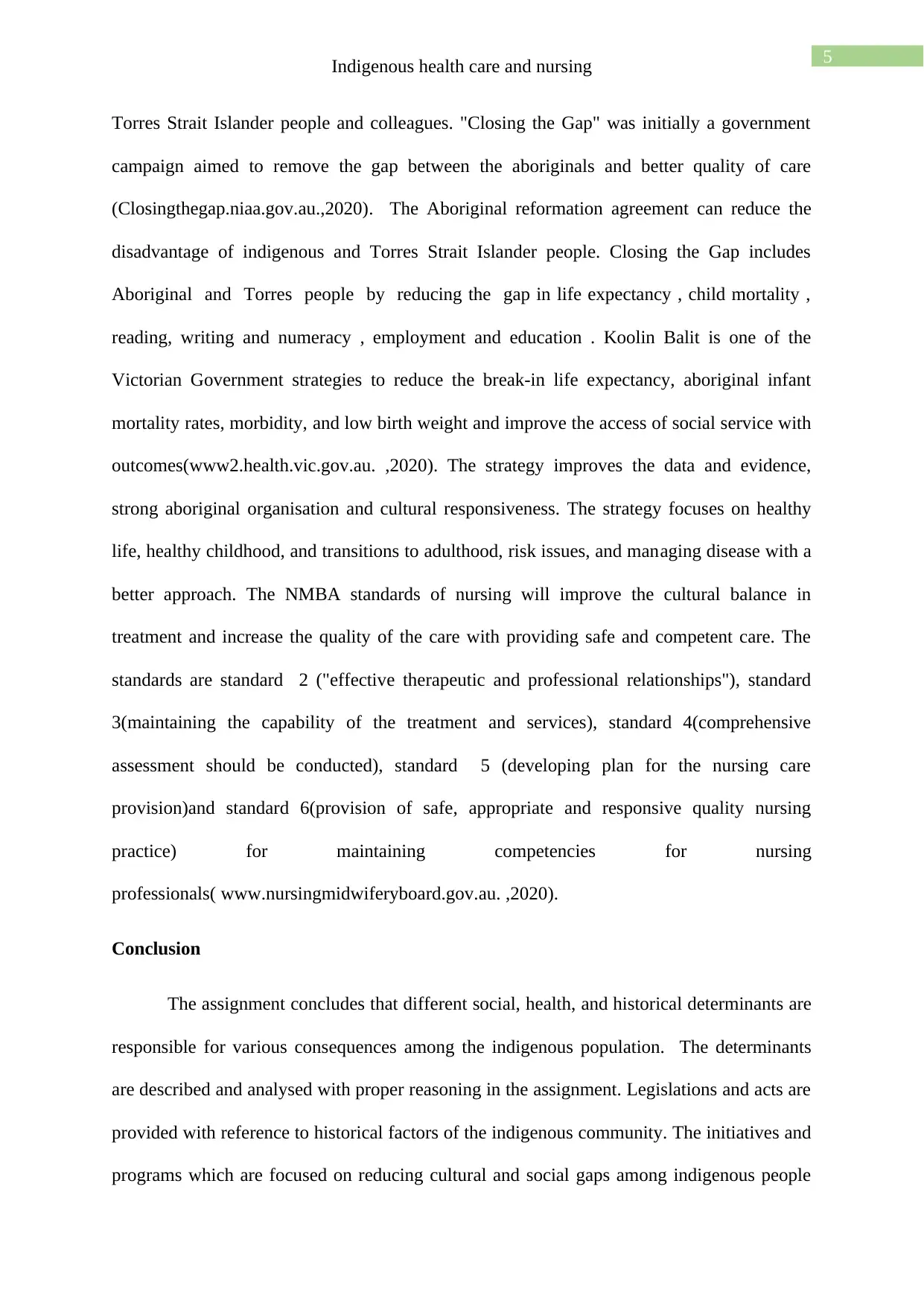
5
Indigenous health care and nursing
Torres Strait Islander people and colleagues. "Closing the Gap" was initially a government
campaign aimed to remove the gap between the aboriginals and better quality of care
(Closingthegap.niaa.gov.au.,2020). The Aboriginal reformation agreement can reduce the
disadvantage of indigenous and Torres Strait Islander people. Closing the Gap includes
Aboriginal and Torres people by reducing the gap in life expectancy , child mortality ,
reading, writing and numeracy , employment and education . Koolin Balit is one of the
Victorian Government strategies to reduce the break-in life expectancy, aboriginal infant
mortality rates, morbidity, and low birth weight and improve the access of social service with
outcomes(www2.health.vic.gov.au. ,2020). The strategy improves the data and evidence,
strong aboriginal organisation and cultural responsiveness. The strategy focuses on healthy
life, healthy childhood, and transitions to adulthood, risk issues, and managing disease with a
better approach. The NMBA standards of nursing will improve the cultural balance in
treatment and increase the quality of the care with providing safe and competent care. The
standards are standard 2 ("effective therapeutic and professional relationships"), standard
3(maintaining the capability of the treatment and services), standard 4(comprehensive
assessment should be conducted), standard 5 (developing plan for the nursing care
provision)and standard 6(provision of safe, appropriate and responsive quality nursing
practice) for maintaining competencies for nursing
professionals( www.nursingmidwiferyboard.gov.au. ,2020).
Conclusion
The assignment concludes that different social, health, and historical determinants are
responsible for various consequences among the indigenous population. The determinants
are described and analysed with proper reasoning in the assignment. Legislations and acts are
provided with reference to historical factors of the indigenous community. The initiatives and
programs which are focused on reducing cultural and social gaps among indigenous people
Indigenous health care and nursing
Torres Strait Islander people and colleagues. "Closing the Gap" was initially a government
campaign aimed to remove the gap between the aboriginals and better quality of care
(Closingthegap.niaa.gov.au.,2020). The Aboriginal reformation agreement can reduce the
disadvantage of indigenous and Torres Strait Islander people. Closing the Gap includes
Aboriginal and Torres people by reducing the gap in life expectancy , child mortality ,
reading, writing and numeracy , employment and education . Koolin Balit is one of the
Victorian Government strategies to reduce the break-in life expectancy, aboriginal infant
mortality rates, morbidity, and low birth weight and improve the access of social service with
outcomes(www2.health.vic.gov.au. ,2020). The strategy improves the data and evidence,
strong aboriginal organisation and cultural responsiveness. The strategy focuses on healthy
life, healthy childhood, and transitions to adulthood, risk issues, and managing disease with a
better approach. The NMBA standards of nursing will improve the cultural balance in
treatment and increase the quality of the care with providing safe and competent care. The
standards are standard 2 ("effective therapeutic and professional relationships"), standard
3(maintaining the capability of the treatment and services), standard 4(comprehensive
assessment should be conducted), standard 5 (developing plan for the nursing care
provision)and standard 6(provision of safe, appropriate and responsive quality nursing
practice) for maintaining competencies for nursing
professionals( www.nursingmidwiferyboard.gov.au. ,2020).
Conclusion
The assignment concludes that different social, health, and historical determinants are
responsible for various consequences among the indigenous population. The determinants
are described and analysed with proper reasoning in the assignment. Legislations and acts are
provided with reference to historical factors of the indigenous community. The initiatives and
programs which are focused on reducing cultural and social gaps among indigenous people
⊘ This is a preview!⊘
Do you want full access?
Subscribe today to unlock all pages.

Trusted by 1+ million students worldwide
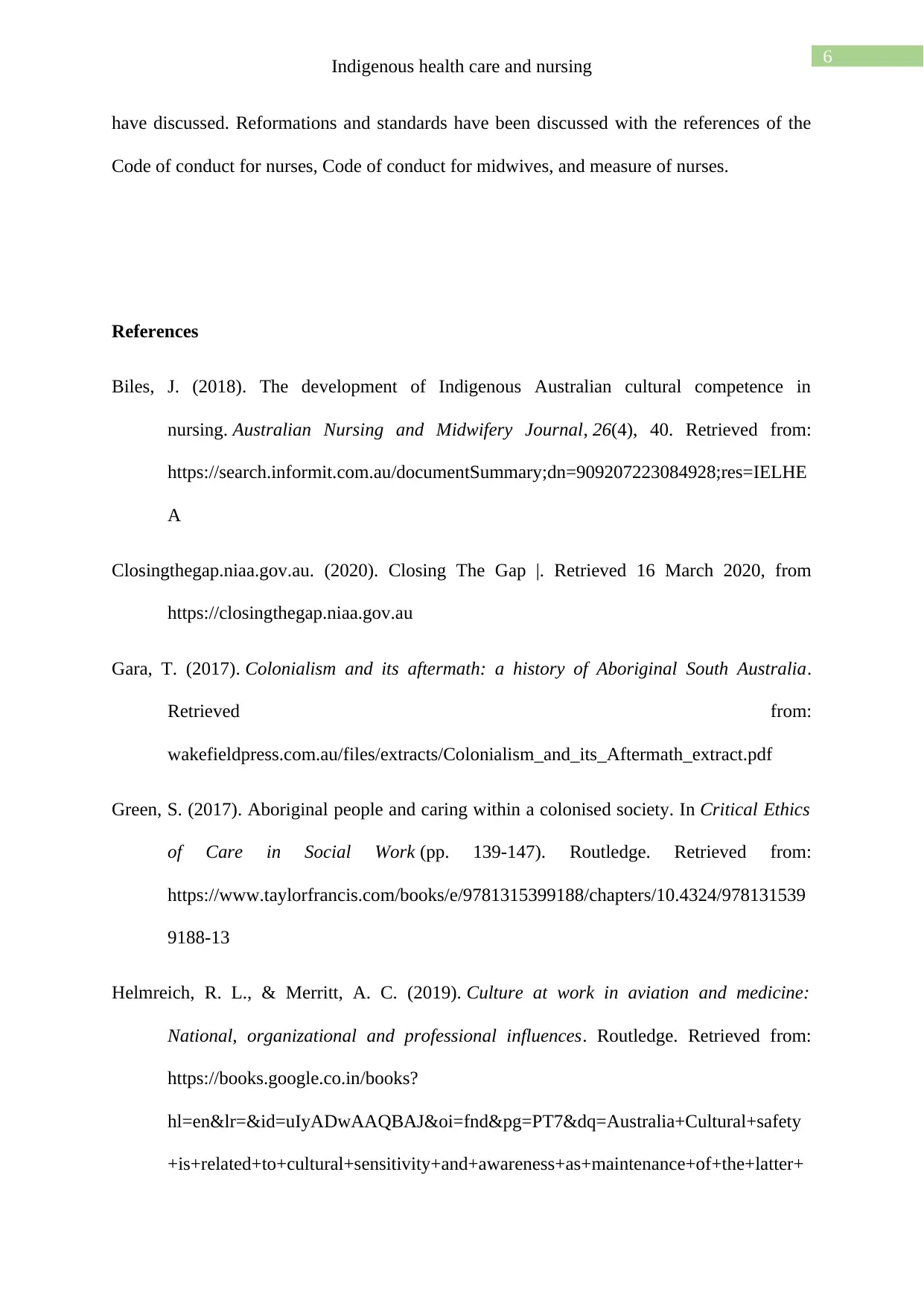
6
Indigenous health care and nursing
have discussed. Reformations and standards have been discussed with the references of the
Code of conduct for nurses, Code of conduct for midwives, and measure of nurses.
References
Biles, J. (2018). The development of Indigenous Australian cultural competence in
nursing. Australian Nursing and Midwifery Journal, 26(4), 40. Retrieved from:
https://search.informit.com.au/documentSummary;dn=909207223084928;res=IELHE
A
Closingthegap.niaa.gov.au. (2020). Closing The Gap |. Retrieved 16 March 2020, from
https://closingthegap.niaa.gov.au
Gara, T. (2017). Colonialism and its aftermath: a history of Aboriginal South Australia.
Retrieved from:
wakefieldpress.com.au/files/extracts/Colonialism_and_its_Aftermath_extract.pdf
Green, S. (2017). Aboriginal people and caring within a colonised society. In Critical Ethics
of Care in Social Work (pp. 139-147). Routledge. Retrieved from:
https://www.taylorfrancis.com/books/e/9781315399188/chapters/10.4324/978131539
9188-13
Helmreich, R. L., & Merritt, A. C. (2019). Culture at work in aviation and medicine:
National, organizational and professional influences. Routledge. Retrieved from:
https://books.google.co.in/books?
hl=en&lr=&id=uIyADwAAQBAJ&oi=fnd&pg=PT7&dq=Australia+Cultural+safety
+is+related+to+cultural+sensitivity+and+awareness+as+maintenance+of+the+latter+
Indigenous health care and nursing
have discussed. Reformations and standards have been discussed with the references of the
Code of conduct for nurses, Code of conduct for midwives, and measure of nurses.
References
Biles, J. (2018). The development of Indigenous Australian cultural competence in
nursing. Australian Nursing and Midwifery Journal, 26(4), 40. Retrieved from:
https://search.informit.com.au/documentSummary;dn=909207223084928;res=IELHE
A
Closingthegap.niaa.gov.au. (2020). Closing The Gap |. Retrieved 16 March 2020, from
https://closingthegap.niaa.gov.au
Gara, T. (2017). Colonialism and its aftermath: a history of Aboriginal South Australia.
Retrieved from:
wakefieldpress.com.au/files/extracts/Colonialism_and_its_Aftermath_extract.pdf
Green, S. (2017). Aboriginal people and caring within a colonised society. In Critical Ethics
of Care in Social Work (pp. 139-147). Routledge. Retrieved from:
https://www.taylorfrancis.com/books/e/9781315399188/chapters/10.4324/978131539
9188-13
Helmreich, R. L., & Merritt, A. C. (2019). Culture at work in aviation and medicine:
National, organizational and professional influences. Routledge. Retrieved from:
https://books.google.co.in/books?
hl=en&lr=&id=uIyADwAAQBAJ&oi=fnd&pg=PT7&dq=Australia+Cultural+safety
+is+related+to+cultural+sensitivity+and+awareness+as+maintenance+of+the+latter+
Paraphrase This Document
Need a fresh take? Get an instant paraphrase of this document with our AI Paraphraser
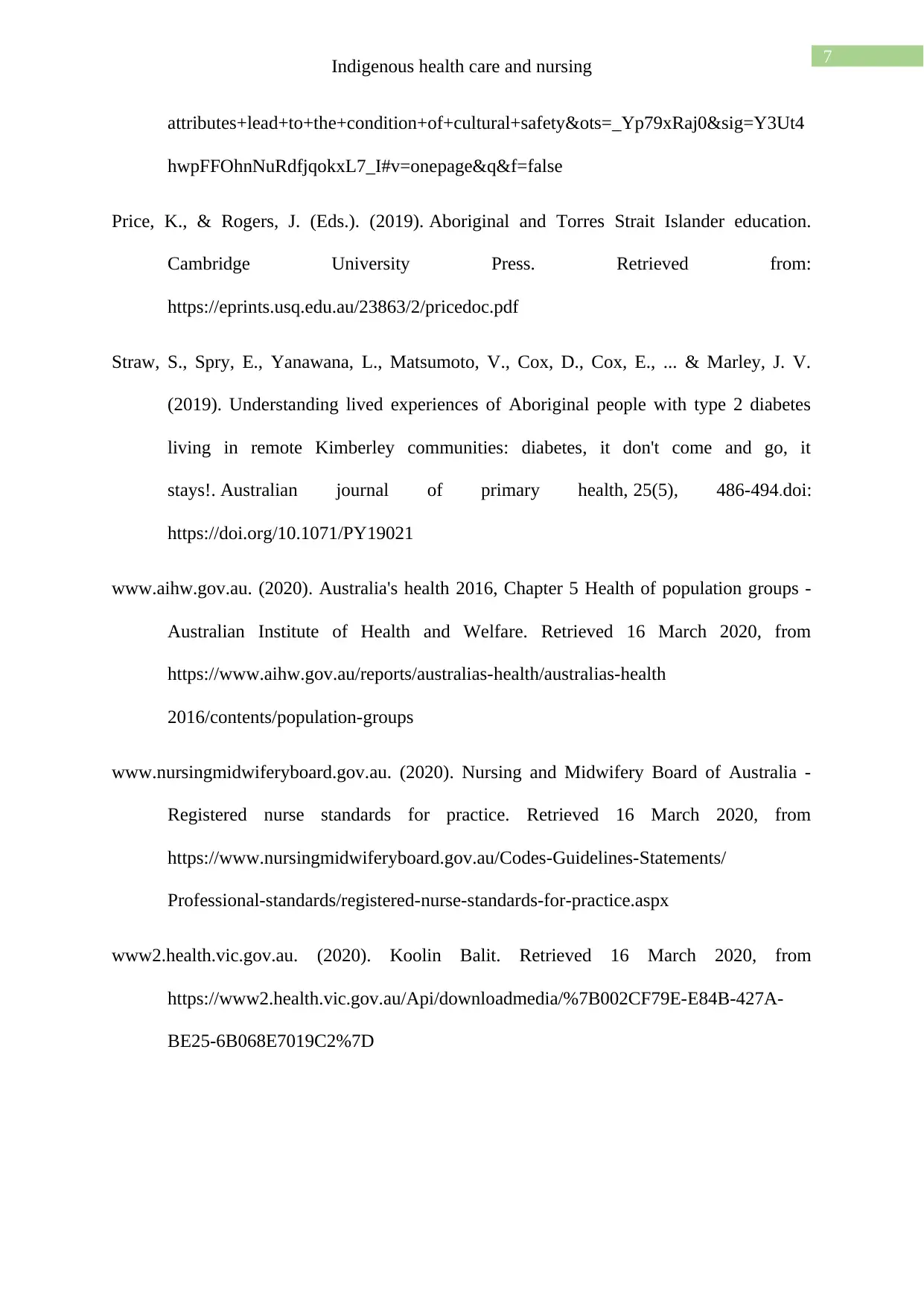
7
Indigenous health care and nursing
attributes+lead+to+the+condition+of+cultural+safety&ots=_Yp79xRaj0&sig=Y3Ut4
hwpFFOhnNuRdfjqokxL7_I#v=onepage&q&f=false
Price, K., & Rogers, J. (Eds.). (2019). Aboriginal and Torres Strait Islander education.
Cambridge University Press. Retrieved from:
https://eprints.usq.edu.au/23863/2/pricedoc.pdf
Straw, S., Spry, E., Yanawana, L., Matsumoto, V., Cox, D., Cox, E., ... & Marley, J. V.
(2019). Understanding lived experiences of Aboriginal people with type 2 diabetes
living in remote Kimberley communities: diabetes, it don't come and go, it
stays!. Australian journal of primary health, 25(5), 486-494.doi:
https://doi.org/10.1071/PY19021
www.aihw.gov.au. (2020). Australia's health 2016, Chapter 5 Health of population groups -
Australian Institute of Health and Welfare. Retrieved 16 March 2020, from
https://www.aihw.gov.au/reports/australias-health/australias-health
2016/contents/population-groups
www.nursingmidwiferyboard.gov.au. (2020). Nursing and Midwifery Board of Australia -
Registered nurse standards for practice. Retrieved 16 March 2020, from
https://www.nursingmidwiferyboard.gov.au/Codes-Guidelines-Statements/
Professional-standards/registered-nurse-standards-for-practice.aspx
www2.health.vic.gov.au. (2020). Koolin Balit. Retrieved 16 March 2020, from
https://www2.health.vic.gov.au/Api/downloadmedia/%7B002CF79E-E84B-427A-
BE25-6B068E7019C2%7D
Indigenous health care and nursing
attributes+lead+to+the+condition+of+cultural+safety&ots=_Yp79xRaj0&sig=Y3Ut4
hwpFFOhnNuRdfjqokxL7_I#v=onepage&q&f=false
Price, K., & Rogers, J. (Eds.). (2019). Aboriginal and Torres Strait Islander education.
Cambridge University Press. Retrieved from:
https://eprints.usq.edu.au/23863/2/pricedoc.pdf
Straw, S., Spry, E., Yanawana, L., Matsumoto, V., Cox, D., Cox, E., ... & Marley, J. V.
(2019). Understanding lived experiences of Aboriginal people with type 2 diabetes
living in remote Kimberley communities: diabetes, it don't come and go, it
stays!. Australian journal of primary health, 25(5), 486-494.doi:
https://doi.org/10.1071/PY19021
www.aihw.gov.au. (2020). Australia's health 2016, Chapter 5 Health of population groups -
Australian Institute of Health and Welfare. Retrieved 16 March 2020, from
https://www.aihw.gov.au/reports/australias-health/australias-health
2016/contents/population-groups
www.nursingmidwiferyboard.gov.au. (2020). Nursing and Midwifery Board of Australia -
Registered nurse standards for practice. Retrieved 16 March 2020, from
https://www.nursingmidwiferyboard.gov.au/Codes-Guidelines-Statements/
Professional-standards/registered-nurse-standards-for-practice.aspx
www2.health.vic.gov.au. (2020). Koolin Balit. Retrieved 16 March 2020, from
https://www2.health.vic.gov.au/Api/downloadmedia/%7B002CF79E-E84B-427A-
BE25-6B068E7019C2%7D
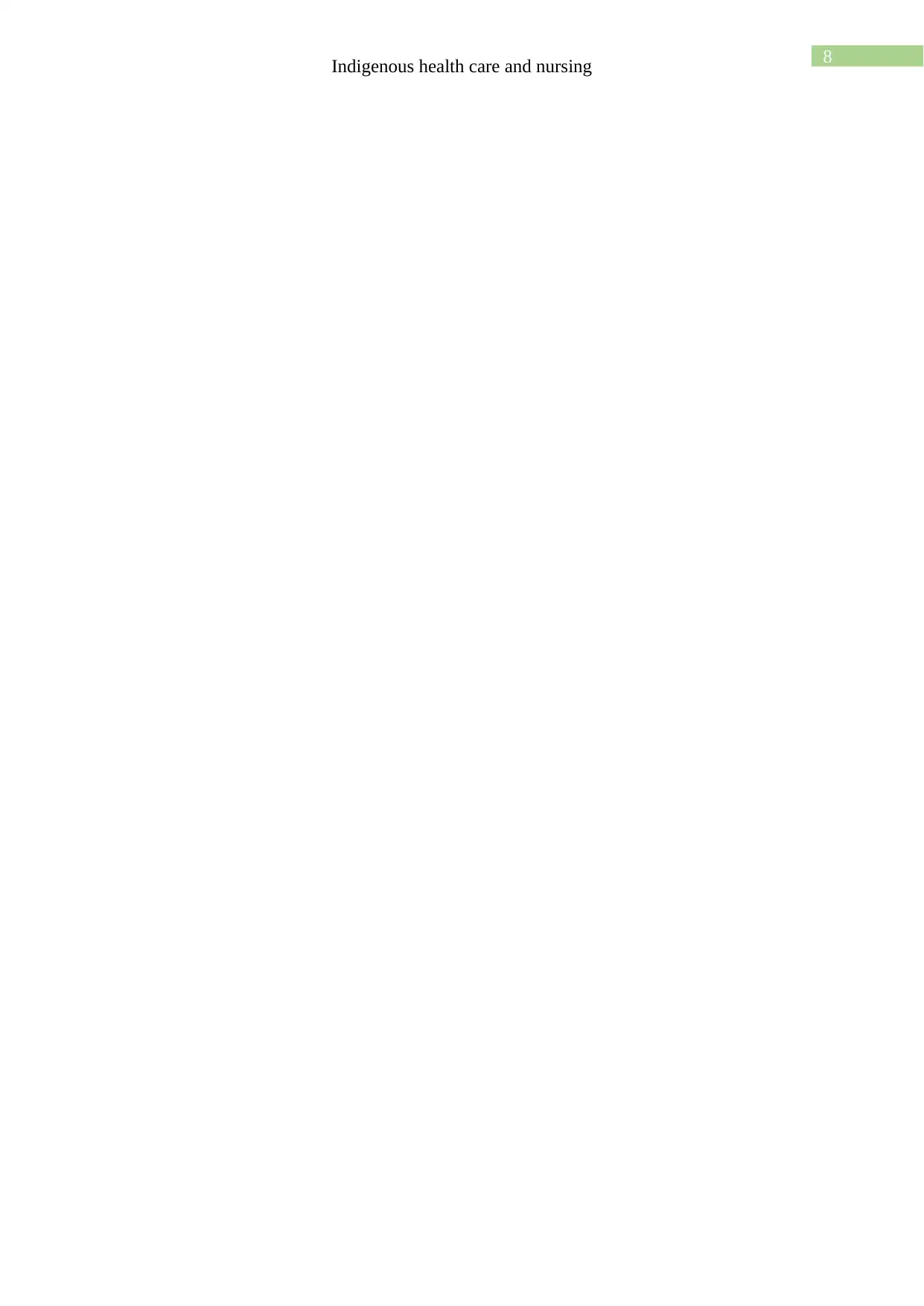
8
Indigenous health care and nursing
Indigenous health care and nursing
⊘ This is a preview!⊘
Do you want full access?
Subscribe today to unlock all pages.

Trusted by 1+ million students worldwide
1 out of 9
Related Documents
Your All-in-One AI-Powered Toolkit for Academic Success.
+13062052269
info@desklib.com
Available 24*7 on WhatsApp / Email
![[object Object]](/_next/static/media/star-bottom.7253800d.svg)
Unlock your academic potential
Copyright © 2020–2025 A2Z Services. All Rights Reserved. Developed and managed by ZUCOL.





